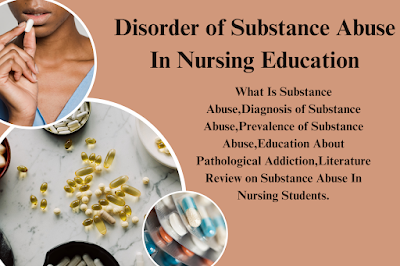Substance Abuse In Nursing Education
What Is Substance Abuse,Diagnosis of Substance Abuse,Prevalence of Substance Abuse,Education About Pathological Addiction,Literature Review on Substance Abuse In Nursing Students.
What Is Substance Abuse
Substance abuse is defined as a disorder comprised of a collection
of symptoms including behavioral, cognitive, and physiological components
(American Psychiatric Association [APAL, 2013). A person with substance abuse
continues using the substance or substances despite significant problems with
role responsibilities, legal issues, and relational conflicts.
Diagnosis of Substance Abuse
The diagnosis of a substance use disorder (APA, 2013) is determined by an array of behaviors over a calendar year, leading to a substantial impairment in functioning. including an inability to complete key family responsibilities, education, or work obligations, and placing yourself or others in dangerous situations and legal problems. Relapse and drug craving are common in those persons with a long-term history of substance abuse when exposed to drug-related stimuli.
Prevalence of Substance Abuse
The National Survey on Drug Use and Health (NSDUH) is a survey which documents substance abuse prevalence in the United States. Research findings revealed that substance use and dependency is a threat, which occurs in approximately 6% of the US population (US Department of Health and Human Services [DHHS), 2013). The age groups that are most affected by illicit drug use are among young adults (18-25 years) and middle-aged adults (50-59 years), which link to the typical ages of traditional nursing students and the nursing workforce.
The most commonly abused substances are marijuana, pain relievers
for non-medical use, and cocaine. The documented number of persons who admitted
heroin use has almost doubled since (373,000 to 620,000). Men and persons 400/4 with mental health comorbidities are at risk for chemical dependency.
Education About Pathological Addiction
Student nurses must be educated on the pathology of addiction, risk
and protective factors, the signs and symptoms of substance use, addiction and
withdrawal, treatment options, potential for recovery, nursing interventions,
therapeutic responses, and anticipatory guidance to educate and support
families of those affected by substance abuse. Sullivan (1995) documented that
substance abuse content typically includes 1 to 5 hours over the entirety of
the nursing program. Topics may be embedded into lectures tied to pathology of
disease and elective courses.
Nurses may not recognize substance abuse and be unprepared to manage abuse issues. Some nurses hold negative attitudes toward patients with substance abuse issues and recovery and often prefer not caring for them (Beckstead, 2002, 2005; Happell, Carta, & Pinikahana, 2002; Kornegay Bugle, Jackson, & Rives, 2004). Students must be prepared to recognize and report peers with suspected impairment. Health care providers who are suspected of substance misuse are generally not confronted by their peers using the Don't Ask Don't Tell attitude (Monroe &e Kenaga, 2011)
The relevant review of literature on substance use and abuse as it
relates to the discipline of nursing includes prevalence; risk factors for
misuse, knowledge and attitudes of student nurses, nurses, and other health
care professionals regarding patients or colleagues who misuse substances;
management concerns such as disciplinary efforts or alternatives to discipline
and reentry into practice guidelines; and nursing curricula related to
substance abuse. Studies directly linking nursing students, nurses, and nursing
faculty with substance abuse or dependency are limited. Often, terms used for
substance abuse are used interchangeably and include chemical use, abuse or
misuse, dependency or impairment, addiction, and withdrawal.
Literature Review on Substance Abuse In Nursing Students
Students should understand the risk and protective factors for alcohol and drug use.Nurse educators need to be aware of the most common risk factors for alcohol and drug use. These are parental approval of drug and alcohol use, parental monitoring, parental or older siblings with drug and alcohol use, development of antisocial behavior, associating with peers with problem behavior, risk-taking behavior, poor school performance, and easy access to alcohol or drugs (Haber, 2001; DHHS, 2013, West, 2003). Students need a solid understanding of the nursing practice act and their legal obligation to report substance abuse.




Give your opinion if have any.